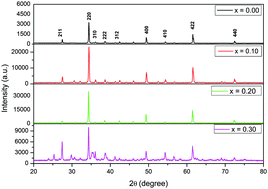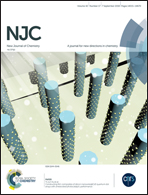Microstructure, crystal structure modelling and dielectric properties of Y2/3Cu3−xZnxTi4O12 (x = 0.10, 0.20 and 0.30) ceramics
Abstract
Different concentration variants of Y2/3Cu3−xZnxTi4O12 (x = 0.00, 0.10, 0.20 and 0.30) ceramics were fabricated by the semi-wet route at a lower sintering temperature of 950 °C. The effect of zinc substitution at the Cu-site in yttrium copper titanate in the context of the microstructure, dielectric and magnetic properties has been discussed and reported in this paper. XRD demonstrated a single phase formation of YCZTO ceramic only up to the concentration x = 0.20. Rietveld refinement of the XRD profile gave the space group Im![[3 with combining macron]](https://www.rsc.org/images/entities/char_0033_0304.gif) , which crystallizes in a pseudo-cubic phase with no change during its refinement. SEM studies revealed the presence of small grains in two different ranges, 1–2 μm and 2–3 μm, with no distinct grain boundaries in any composition. SAED patterns obtained by TEM also suggested the formation of a thermodynamically stable polycrystalline phase of YCZTO ceramics. A thin film of Y2/3Cu3−xZnxTi4O12 (x = 0.00 and 0.10) ceramic, when subjected to AFM studies, revealed that both undoped and zinc-doped YCTO ceramics exhibited a Leptokurtic type of distribution of round shaped grains with an average size of 59 nm and 90.8 nm. With an increase in the temperature, both dielectric constant and dielectric loss increase. A magnetic study confirmed that the ceramic remains in the paramagnetic phase at 300 K, although it undergoes an antiferromagnetic to paramagnetic transition around its Neel temperature.
, which crystallizes in a pseudo-cubic phase with no change during its refinement. SEM studies revealed the presence of small grains in two different ranges, 1–2 μm and 2–3 μm, with no distinct grain boundaries in any composition. SAED patterns obtained by TEM also suggested the formation of a thermodynamically stable polycrystalline phase of YCZTO ceramics. A thin film of Y2/3Cu3−xZnxTi4O12 (x = 0.00 and 0.10) ceramic, when subjected to AFM studies, revealed that both undoped and zinc-doped YCTO ceramics exhibited a Leptokurtic type of distribution of round shaped grains with an average size of 59 nm and 90.8 nm. With an increase in the temperature, both dielectric constant and dielectric loss increase. A magnetic study confirmed that the ceramic remains in the paramagnetic phase at 300 K, although it undergoes an antiferromagnetic to paramagnetic transition around its Neel temperature.



 Please wait while we load your content...
Please wait while we load your content...